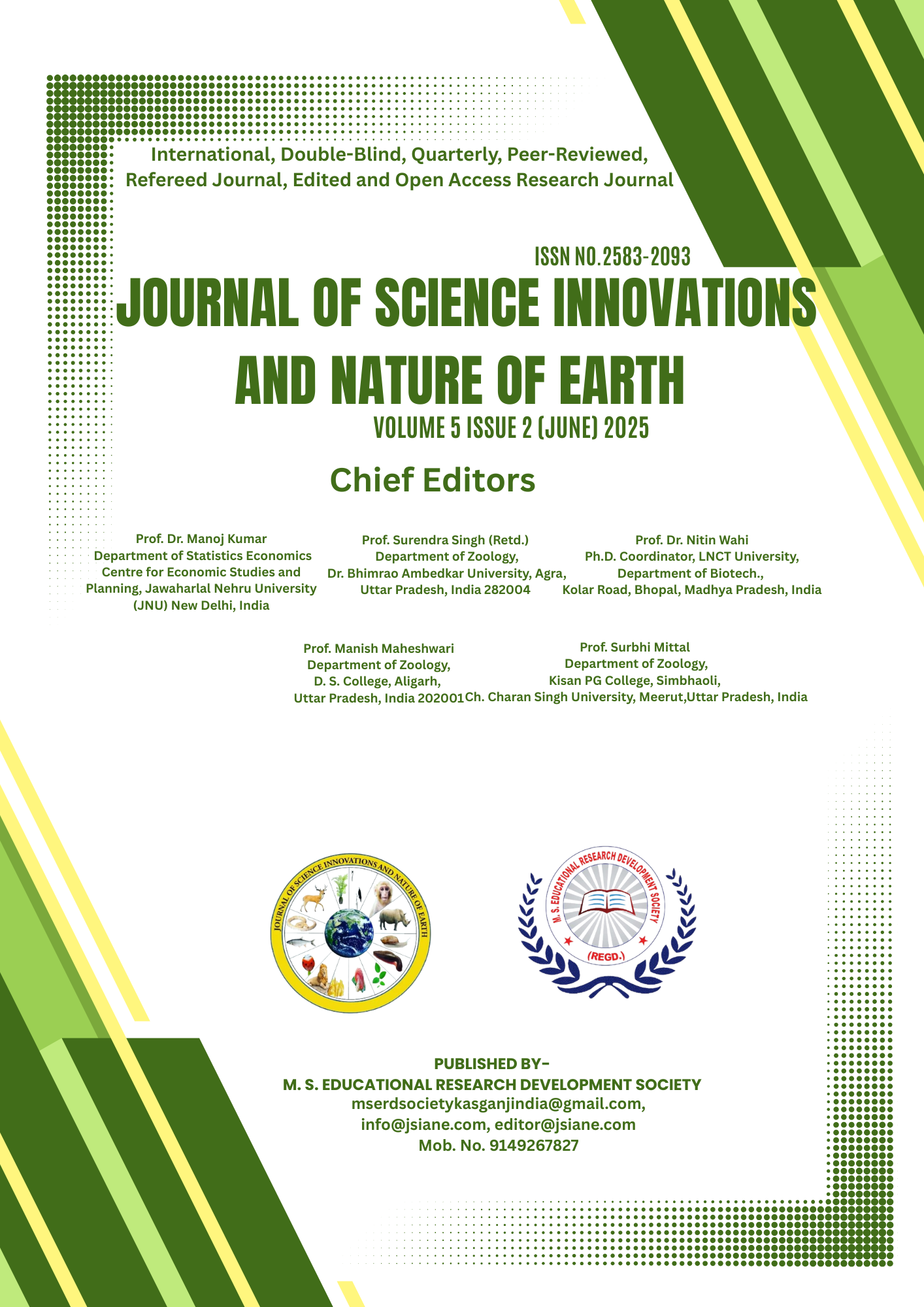Host-Parasite Coevolution in Wild Rodents: Dynamics, Mechanisms and Evolutionary Consequences
DOI:
https://doi.org/10.59436/jsiane.373.2583-2093Keywords:
Coevolution, Rodents, Parasites, Immunity, AdaptationAbstract
Host-parasite coevolution is a fundamental evolutionary process wherein hosts and their parasites exert reciprocal selective pressures on each other, driving genetic and phenotypic changes over generations. Wild rodents, due to their ecological ubiquity, rapid reproductive cycles, and genetic variability, serve as ideal systems for studying these coevolutionary dynamics in natural settings. This paper explores the complex interactions between wild rodent species and a diverse array of parasites including protozoa, helminths, ectoparasites, and vector-borne pathogens by analyzing immune gene evolution, patterns of local adaptation, and parasite virulence traits. Using a combination of field studies, molecular genetics, and experimental infections, the research reveals strong evidence of Red Queen dynamics and geographic mosaic coevolution. Findings demonstrate that host immune genes, especially those related to the MHC and innate immune pathways, evolve rapidly in response to regionally distinct parasite populations, while parasites exhibit parallel adaptations to evade or manipulate host defenses. These dynamic and localized evolutionary interactions not only deepen our understanding of coevolutionary theory but also have critical implications for managing zoonotic diseases, as wild rodents often act as reservoirs for pathogens with public health relevance
References
Barreiro, L. B., & Quintana-Murci, L. (2020). Evolutionary and population (epi)genetics of immunity to infection. Human Genetics, 139(6-7), 723–732. https://doi.org/10.1007/s00439-020-02147-w
Cizauskas, C. A., Ezenwa, V. O., & Craft, M. E. (2017). Interactions between multiple parasites in a wild host: Coinfection and immune responses. Journal of Animal Ecology, 86(3), 601–610. https://doi.org/10.1111/1365-2656.12688
Deter, J., Cosson, J. F., Charbonnel, N., & Morand, S. (2008). Coevolution of MHC genes and helminth communities in rodents: A parasitological perspective. Infection, Genetics and Evolution, 8(5), 574–578. https://doi.org/10.1016/j.meegid.2008.04.004
Eizaguirre, C., Lenz, T. L., Kalbe, M., & Milinski, M. (2012). Rapid and adaptive evolution of MHC genes under parasite selection in experimental vertebrate populations. Nature Communications, 3, 621. https://doi.org/10.1038/ncomms1632
Fenton, A., Streicker, D. G., Petchey, O. L., & Pedersen, A. B. (2015). Are all hosts created equal? Partitioning parasite transmission risk in multihost communities. Nature Reviews Microbiology, 13(11), 802–810. https://doi.org/10.1038/nrmicro3533
Grech, K., Watt, K., & Read, A. F. (2006). Host–parasite interactions for virulence and resistance in a malaria model system. Journal of Evolutionary Biology, 19(5), 1620–1630. https://doi.org/10.1111/j.1420-9101.2006.01113.x
Lively, C. M., & Dybdahl, M. F. (2000). Parasite adaptation to locally common host genotypes. Nature, 405(6787), 679–681. https://doi.org/10.1038/35015069
Luis, A. D., Hayman, D. T. S., O’Shea, T. J., Cryan, P. M., Gilbert, A. T., Pulliam, J. R. C., ... & Webb, C. T. (2013). A comparison of bats and rodents as reservoirs of zoonotic viruses: Are bats special? Proceedings of the Royal Society B: Biological Sciences, 280(1756), 20122753. https://doi.org/10.1098/rspb.2012.2753
Morand, S., Bordes, F., Chen, H. W., Claude, J., Cosson, J. F., Galan, M., ... & Michaux, J. R. (2015). Global parasite and Rattus rodent diversity: Testing the correlation and highlighting the influence of sampling bias. PLOS ONE, 10(7), e0134504. https://doi.org/10.1371/journal.pone.0134504
Oliver, M. K., Telfer, S., & Piertney, S. B. (2020). Host-parasite coevolution and patterns of MHC variation in wild rodent populations. Heredity, 124(1), 69–83. https://doi.org/10.1038/s41437-019-0263-5
Schmid, M., Rödder, D., & Scharsack, J. P. (2022). Genetic structure and antigenic diversity of Eimeria spp. in wild mice: Evidence for local adaptation to host immunity. Parasitology Research, 121(5), 1379–1390. https://doi.org/10.1007/s00436-022-07487-0
Stothard, J. R., Cheke, R. A., & Rollinson, D. (2021). The epidemiology and evolution of zoonotic parasitic diseases in urbanizing environments. Trends in Parasitology, 37(9), 766–779. https://doi.org/10.1016/j.pt.2021.06.002
Thompson, J. N. (2005). The geographic mosaic of coevolution. University of Chicago Press.
Turner, A. K., Begon, M., Jackson, J. A., & Bradley, J. E. (2021). Evolutionary and ecological genetics of immune defense in wild rodents. Molecular Ecology, 30(3), 659–674. https://doi.org/10.1111/mec.15751
Van Valen, L. (1973). A new evolutionary law. Evolutionary Theory, 1, 1–30.
Woolhouse, M. E. J., Webster, J. P., Domingo, E., Charlesworth, B., & Levin, B. R. (2002). Biological and biomedical implications of the co-evolution of pathogens and their hosts. Nature Genetics, 32(4), 569–577. https://doi.org/10.1038/ng1202-569
Anderson, R. M., & May, R. M. (1982). Coevolution of hosts and parasites. Parasitology, 85(2), 411–426. https://doi.org/10.1017/S0031182000055360
Fenton, A., Knowles, S. C., Petchey, O. L., & Pedersen, A. B. (2019). The reliability of observational approaches for detecting interspecific parasite interactions: Comparison with experimental results. Ecology Letters, 22(4), 590–600. https://doi.org/10.1111/ele.13220
Fischer, K., Schraiber, J. G., & Streicker, D. G. (2023). Host–parasite coevolution and the emergence of zoonoses. Philosophical Transactions of the Royal Society B, 378(1884), 20220091. https://doi.org/10.1098/rstb.2022.0091
Guivier, E., Galan, M., Henttonen, H., Cosson, J. F., & Charbonnel, N. (2020). Landscape features and helminth co-infection shape bank vole immunoheterogeneity and hantavirus epidemiology. BMC Ecology and Evolution, 20(1), 1–14. https://doi.org/10.1186/s12862-020-01702-z
Kloch, A., Babik, W., & Radwan, J. (2019). Functional polymorphism in TLR genes in relation to parasite load in wild rodents. Molecular Ecology, 28(3), 723–738. https://doi.org/10.1111/mec.14979
Lloyd-Smith, J. O., Biebaut, E., & Turelli, M. (2022). Red Queen dynamics in natural populations: Evidence from wild rodents and their parasites. Ecology Letters, 25(3), 512–523. https://doi.org/10.1111/ele.13927
Loiseau, C., Zoorob, R., Robert, A., & Sorci, G. (2018). Plasmodium and Haemoproteus parasite prevalence and host immune response in wild rodents: A coevolutionary perspective. International Journal for Parasitology, 48(2), 153–162. https://doi.org/10.1016/j.ijpara.2017.09.007
Mendes, R. A., Marra, R. V., & Pereira, L. C. (2021). Urbanization alters parasite communities and immune gene expression in wild rodents. Ecology and Evolution, 11(21), 15242–15255. https://doi.org/10.1002/ece3.8155
Kumar, R., Singh, V., & Tiwari, S. (2021). Rodent ecology and parasite diversity in agricultural habitats of northern India. Journal of Vector Ecology, 46(1), 44–51.
Sharma, N., Verma, A., & Kaushal, D. (2022). Seasonal patterns of rodent parasite load in the Gangetic plains. Indian Journal of Parasitology, 36(2), 105–112.
Mishra, P., & Yadav, R. (2021). Host specificity and parasite fitness in wild rodents under experimental conditions. Journal of Parasitic Diseases, 45(4), 980–988.
Yadav, M., Chauhan, R., & Gupta, K. (2023). Eco-immunological interactions between rodents and their ectoparasites in semi-urban India. Tropical Zoology, 36(1), 22–33.

Downloads
Published
Issue
Section
License
Copyright (c) 2025 Maharaj Singh Educational Research Development Society

This work is licensed under a Creative Commons Attribution-NonCommercial 4.0 International License.









